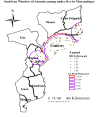Spatial distribution and determinants of anemia among under-five children in Mozambique
- PMID: 39747189
- PMCID: PMC11696623
- DOI: 10.1038/s41598-024-83899-y
Spatial distribution and determinants of anemia among under-five children in Mozambique
Abstract
Worldwide, anemia in under-five children is a serious public health problem that causes significant morbidity and mortality. It also negatively impacts children's physical growth, focus, memory, and academic performance. Despite this, there is a paucity of up-to-date information on the spatial distribution and determinants of under-five anemia in Mozambique. Therefore, this study aimed to assess the spatial variation and determinates of anemia among under-five children in Mozambique by using the most recent demographic and health survey data. A cross-sectional study was conducted using the most recent demographic and health survey data of Mozambique. A total weighted sample of 3127 under-five children was included in the study. Spatial SaTScan statistics were done using Kuldroff's SaTScan version 9.6 software. ArcGIS version 10.7 software is used to visualize the spatial distribution of under-five anemia. A multilevel mixed-effects logistic regression analysis was employed to identify the determinants of under-five anemia. The level of statistical significance was declared at a p-value of < 0.05. Overall, the prevalence of anemia among under-five children in Mozambique was 49.46% (95% CI 47.70-51.21). Under-five anemia was not evenly distributed across the country; a higher distribution was observed in Zambezia, Nampula, Safala, and the southern part of Gaza; fewer cold spots were observed in the western and southern parts of Niassa, the eastern part of Tete, the western part of Manica, and Maputo City. In spatial scan statistics, children in the most likely cluster were 1.58 times more likely to be anemic than those living outside the window (RR = 1.58, P-value < 0.001). Children with fathers with no formal education, children from anemic mothers, children whose mothers are underweight, children residing in the Zambzia region, children residing in the Nampula region, and children residing in the Niassa region were significantly associated with under-five anemia in Mozambique. The burden of under-five anemia in Mozambique is higher and distributed non-randomly across regions. Maternal anemia, underweighted mothers, husband education, and regions in Mozambique were found to be significant determinants of anemia in under-five children. Improving the nutritional status of mothers and interventions to address maternal anemia, with special attention to the Nampula and Zambzia regions, are recommended to reduce under-five anemia in Mozambique.
Keywords: Anemia; Demographic and health survey; Mozambique; Spatial analysis; Under-five.
© 2025. The Author(s).
Conflict of interest statement
Declarations. Competing interests: The authors declare no competing interests.
Figures





Similar articles
-
Spatial variation and predictors of anemia among women of reproductive age in Mozambique, 2022/23: a multiscale geographically weighted regression.Front Public Health. 2025 Feb 24;13:1502177. doi: 10.3389/fpubh.2025.1502177. eCollection 2025. Front Public Health. 2025. PMID: 40066016 Free PMC article.
-
Spatial heterogeneity and predictors of stunting among under five children in Mozambique: a geographically weighted regression.Front Public Health. 2024 Dec 18;12:1502018. doi: 10.3389/fpubh.2024.1502018. eCollection 2024. Front Public Health. 2024. PMID: 39744381 Free PMC article.
-
Geographic weighted regression analysis of hot spots of anemia and its associated factors among children aged 6-59 months in Ethiopia: A geographic weighted regression analysis and multilevel robust Poisson regression analysis.PLoS One. 2021 Nov 4;16(11):e0259147. doi: 10.1371/journal.pone.0259147. eCollection 2021. PLoS One. 2021. PMID: 34735486 Free PMC article.
-
Geographic differentials in mortality of children in Mozambique: their implications for achievement of Millennium Development Goal 4.J Health Popul Nutr. 2012 Sep;30(3):331-45. doi: 10.3329/jhpn.v30i3.12297. J Health Popul Nutr. 2012. PMID: 23082635 Free PMC article.
-
Prevalence of anemia in India: a systematic review, meta-analysis and geospatial analysis.BMC Public Health. 2025 Apr 4;25(1):1270. doi: 10.1186/s12889-025-22439-3. BMC Public Health. 2025. PMID: 40186206 Free PMC article.
Cited by
-
Childhood Anemia in Mozambique: A Multilevel Mixed-Effects Analysis of 2011-2022/23 Population-Based Surveys.Healthcare (Basel). 2025 Mar 14;13(6):635. doi: 10.3390/healthcare13060635. Healthcare (Basel). 2025. PMID: 40150485 Free PMC article.
References
-
- Gao, J. & Monaghan, S. A. Red Blood cell/hemoglobin Disordersp. 3–56 (Elsevier, 2018). e2.
-
- Organization, U. N. W. H. Iron Deficiency Anaemia: Assesment, Prevention and Control: A Guide for Programme Managers (World Health Organization, 2001).
-
- Brabin, B. J., Premji, Z., Verhoeff & FJTJon Anal. anemia Child. Mortal. ;131(2):636S–48S. (2001). - PubMed
-
- Ramakrishnan, U. Functional Consequences of Nutritional anemia during Pregnancy and Early Childhood (CRC Press, LLC, 2001).
-
- Villalpando, S., Shamah-Levy, T., Ramírez-Silva, C. I., Mejía-Rodríguez, F. & Rivera, J. A. J. S. M. Prevalence of anemia in children 1 to 12 years of age: results from a nationwide probabilistic survey in Mexico. ;45:490–498. (2003). - PubMed
MeSH terms
LinkOut - more resources
Full Text Sources
Medical

